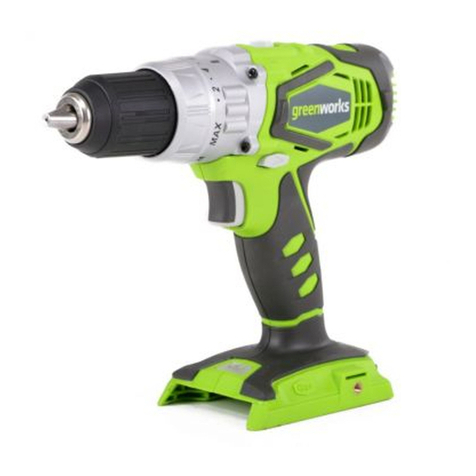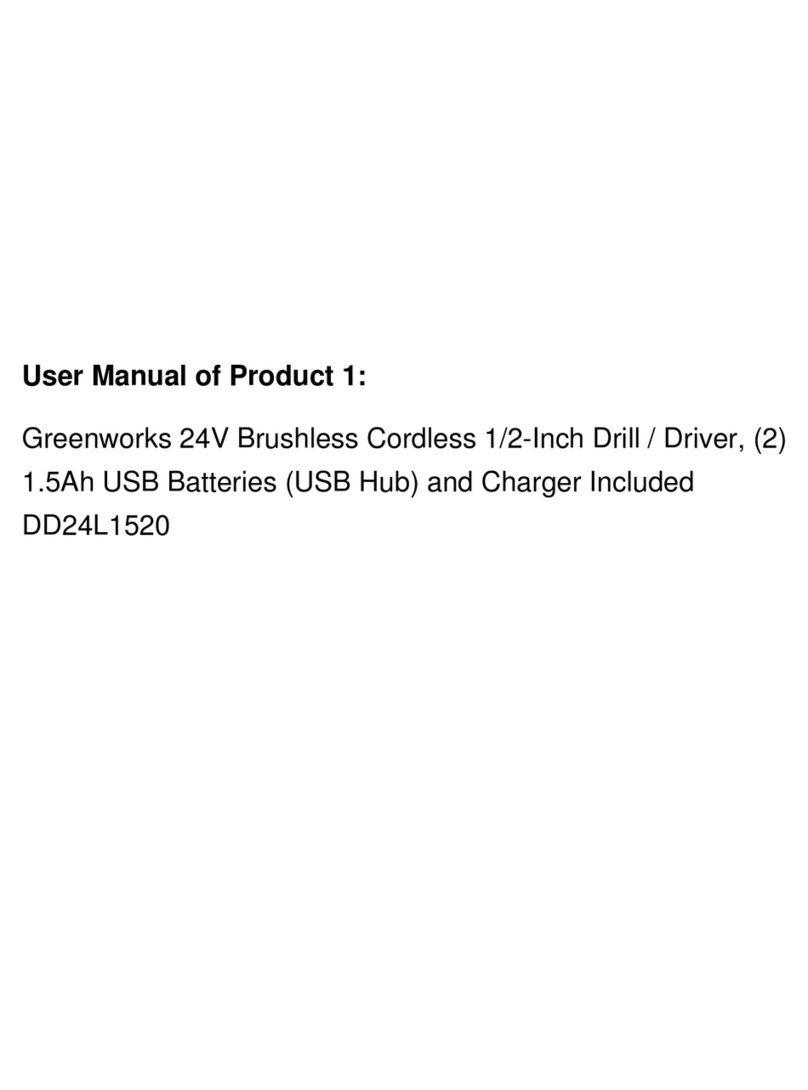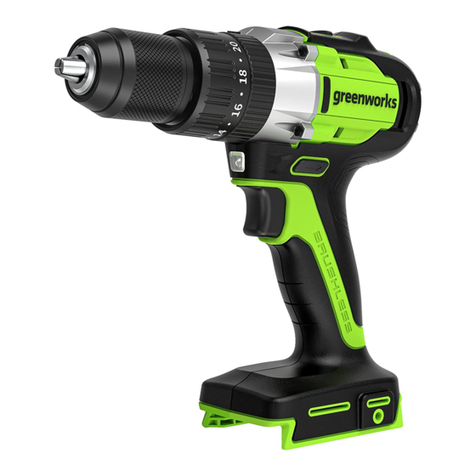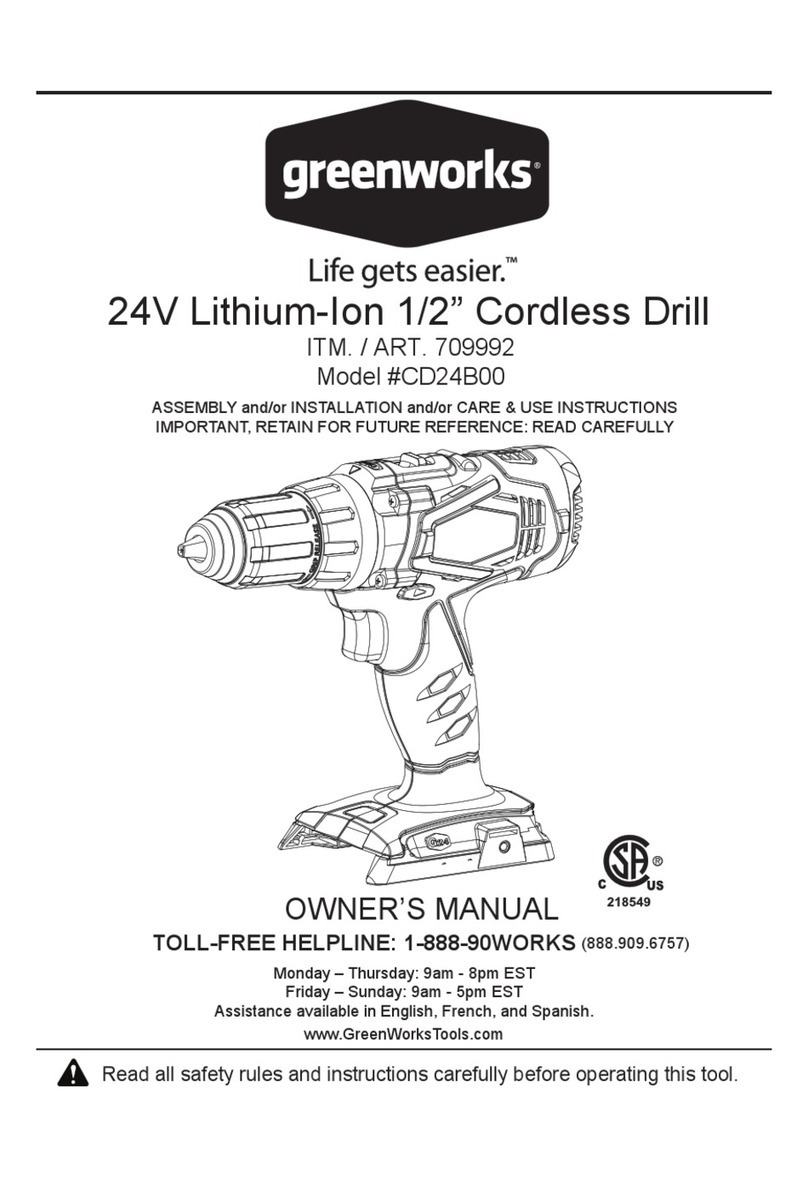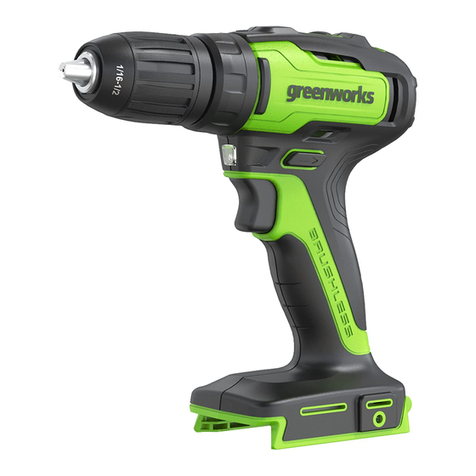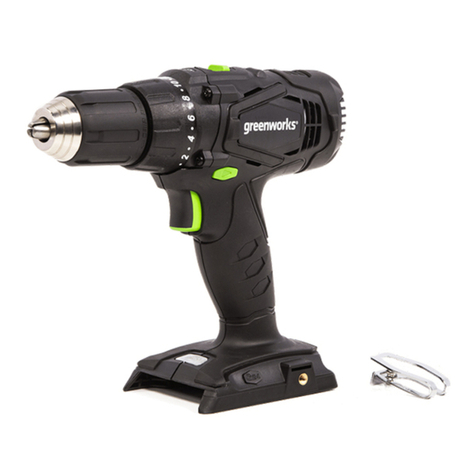
2.4 POWER TOOL USE AND CARE
•Do not force the power tool. Use the correct power
tool for your application. The correct power tool will do
the job better and safer at the rate for which it was
designed.
•Do not use the power tool if the switch does not turn it
on and off. Any power tool that cannot be controlled with
the switch is dangerous and must be repaired.
•Disconnect the plug from the power source and/or the
battery pack from the power tool before making any
adjustments, changing accessories, or storing power
tools. Such preventive safety measures reduce the risk of
starting the power tool accidentally.
•Store idle power tools out of the reach of children and
do not allow persons unfamiliar with the power tool or
these instructions to operate the power tool. Power
tools are dangerous in the hands of untrained users.
•Maintain power tools and accessories. Check for
misalignment or binding of moving parts, breakage of
parts and any other condition that may affect the
power tool’s operation. If damaged, have the power
tool repaired before use. Many accidents are caused by
poorly maintained power tools.
•Keep cutting tools sharp and clean. Properly
maintained cutting tools with sharp cutting edges are less
likely to bind and are easier to control.
•Use the power tool, accessories and tool bits etc. in
accordance with these instructions, taking into
account the working conditions and the work to be
performed. Use of the power tool for operations different
from those intended could result in a hazardous situation.
•Keep handles and grasping surfaces dry, clean and
free from oil and grease. Slippery handles and grasping
surfaces do not allow for safe handling and control of the
tool in unexpected situations.
2.5 BATTERY TOOL USE AND CARE
•Recharge only with the charger specified by the
manufacturer. A charger that is suitable for one type of
battery pack may create a risk of fire when used with
another battery pack.
•Use power tools only with specifically designated
battery packs. Use of any other battery packs may create
a risk of injury and fire.
•When battery pack is not in use, keep it away from
other metal objects like paper clips, coins, keys, nails,
screws, or other small metal objects that can make a
connection from one terminal to another. Shorting the
battery terminals together may cause burns or fire.
•Under abusive conditions, liquid may be ejected from
the battery; avoid contact. If contact accidentally
occurs, flush with plenty of soap and water. If liquid
contacts eyes, immediately seek medical help. Liquid
ejected from the battery may cause irritation or burns.
•Do not use a battery pack or tool that is damaged or
modified. Damaged or modified batteries may exhibit
unpredictable behaviour resulting in fire, explosion or
risk of injury.
•Do not expose a battery pack or tool to fire or
excessive temperature. Exposure to fire or temperature
above 130 °C may cause explosion.
•Follow all charging instructions and do not charge the
battery pack or tool outside the temperature range
specified in the instructions. Charging improperly or at
temperatures outside the specified range may damage the
battery and increase the risk of fire.
2.6 SERVICE
•Have your power tool serviced by a qualified repair
person using only identical replacement parts. This
will ensure that the safety of the power tool is maintained.
•Never service damaged battery packs. Service of
battery packs should only be performed by the
manufacturer or authorized service providers.
3 DRILL SAFETY WARNINGS
•Wear ear protectors when impact drilling. Exposure to
noise can cause hearing loss.
•Hold the power tool by insulated gripping surfaces,
when performing an operation where the cutting
accessory may contact hidden wiring. Cutting
accessory or fasteners contacting a "live" wire may make
exposed metal parts of the power tool "live" and could
give the operator an electric shock.
•Never operate at higher speed than the maximum
speed rating of the drill bit. At higher speeds, the bit is
likely to bend if allowed to rotate freely without
contacting the workpiece, resulting in personal injury.
•Always start drilling at low speed and with the bit tip
in contact with the workpiece. At higher speeds, the bit
is likely to bend if allowed to rotate freely without
contacting the workpiece, resulting in personal injury.
•Apply pressure only in direct line with the bit and do
not apply excessive pressure. Bits can bend causing
breakage or loss of control, resulting in personal injury.
•Know your power tool. Read operator manual
carefully.Learn its applications and limitations, as well
as the specific potential hazards related to this power
tool. Obey this instruction will reduce shock, fire or
serious injury.
•Always wear safety glasses with side shields marked to
comply with ANSI Z87.1.Obey this instruction will
reduce the risk of serious injury.
•Protect your lungs. Wear a face or dust mask if the
operation is dusty.Obey this instruction will reduce the
risk of serious injury.
•Protect your hearing. Wear hearing protection during
extended periods of operation.Obey this instruction will
reduce the risk of serious injury.
3
English EN
